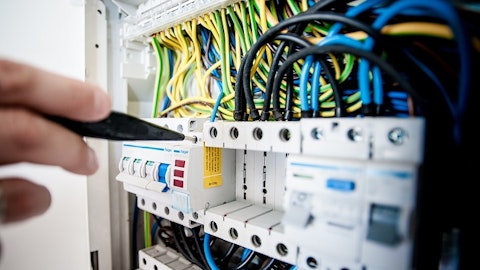Craig Arnold: Yes. It’s certainly one of the things that we’re watching and we’re concerned about as well, Joe. It’s perfectly logical to say that some of these projects could be delayed or put at risk, given much higher financing cost. I will tell you that we’ve not seen any evidence, any material evidence of that to date. But it’s certainly, once again, a potential risk. And that’s why I highlight this issue around 60% of these projects basically being financially supported by these government stimulus plans, which is very new. And the dollars, as you know, are quite substantial. And at this point, we will have to wait and see how it plays out. And we’re going to watch it and make sure that we’re taking the necessary precautions. But to date, we really haven’t seen that impact.
Tom Okray: Joe, year-to-date in the Americas, utility is up over 25%. And if you look at the entire electrical sector year-to-date are up over 20%. So it remains very strong.
Joe Ritchie: Great. Thank you, both.
Operator: Thank you. Our next question is from Jeff Sprague from Vertical Research. Please go ahead.
Jeff Sprague: Thank you. Good morning, everyone.
Craig Arnold: Good morning, Jeff.
Jeff Sprague: Hi, good morning. Can we pivot a little bit to Electrical Global? And just maybe a little bit more color on kind of the complexion of demand underneath the surface there by geography. And you noted some project activity starting to come to the floor there. It does seem like Europe, in particular, might end up in a bit of a bidding war with the U.S. on project stimulus and the like. So maybe just a little bit of color there on how you see things playing out into the first half of next year, not just Q4, but what kind of pipeline might be building.
Craig Arnold: Appreciate the question, Jeff. And if you think about today, what makes up the global business for us, there is what we do in Asia, there is what we do and what we call GEIS, which was the former crowd science B-Line business. And then it’s our electrical Europe business. Those are the three pieces that make up global for us. And I will say that we know, without a doubt, did see a slowdown in our European business during the course of our business specifically. We’re a pretty big player into what you call the manufacturing or the OEM segment, and that segment was especially weak. Our business in Asia continued to perform well, growing high single digits. Our GEIS business continued to perform fine, mid-single digit consistent with what we expected.
It’s really what took place during the course of the quarter in Europe, specifically in electrical, that drove the miss of our own expectations and the reduction in our outlook. Now we – without a doubt, we saw some destocking in the distribution channel and having – had a number of conversations in person with some of our large distributors in Europe, it’s clear that they were doing some inventory adjustments, some overbuying that took place over the last 12 months or so. And we do think that, that segment gets back to mid-single-digit growth in Q4. And we think, once again, these fundamental trends that we talked about with respect to electrification, energy transition, digital growth and data centers, all of those trends are applicable for Europe as well.
And so we do think while slower growth than the U.S., we think those markets get back to growth once we work through this inventory correction that we’ve seen here in the third quarter.
Tom Okray: Encouragingly, Jeff, we’ve seen some good order flow in EMEA. So that gives us – it gives us confidence to go to the low mid-single digits in Q4.
Craig Arnold: But we will keep watching it. I mean, clearly, there is a lot of geopolitical tensions in the region there as well. And we’re not going to be pollyannish about it. And if we need to make some adjustments, we will make the adjustments we need to make.
Jeff Sprague: Great. And maybe just as a follow-up, different topic, though, is just thanks for the little many deep dive on data centers here. Can you just speak to how your content is changing? So obviously, you gave us a $1.5 million per megawatt, and we got a lot of megawatts coming, right? So you just grow on the back of that for sure. But is your dollar content per megawatt also going up as part of this equation and how so, where has it been? And where is it headed in your view?
Craig Arnold: Yes. What I would tell you is that the simple answer to the question is yes. We are essentially selling more content per megawatt because we’re selling more software solutions. We’re selling more complete data center solutions into the marketplace. So that would be absolutely true. That impact is kind of dwarfed by just the overall growth in the market though. I mean, the market, as we’ve talked about, continues to be quite robust. And just maybe some of the data if you look at simply the backlog of projects today in data center in the planning stages, it surpassed $100 billion for the first time ever greater than 6 years of construction, $12 billion in the month of September alone, starts up some 29% driven by the big four and some $42 billion under construction.
So the whole market is growing quite dramatically right now. And obviously, what’s happening today in AI is accelerating that. And if you think about the content opportunity for electrical equipment alone in an AI-centric data center, it’s 5x the growth, the opportunity when you compare it to a conventional data center. Now having said that, there clearly are some very real constraints in terms of the industry’s ability to really deal with the demand that’s out in front of us. Huge backlog, huge negotiations. We have historically operated with some 3 years, let’s say, of visibility in data center market. We now have more than, in some cases, 5 years of visibility on projects. And so the whole market is just performing extremely well, and we’d expect it to do so for years to come.
Tom Okray: Just to amplify, Jeff, just a little bit more on that, year-to-date in data centers, again, on our negotiation standpoint up 136%. And in the quarter, as we said in the prepared remarks, up 4x. So it’s growing faster than it was at the beginning of the year as well.
Jeff Sprague: Great. Thank you.
Operator: Our next question is from Scott Davis from Melius Research. Please go ahead.
Scott Davis: Hey, good morning, guys.
Craig Arnold: Hey, Scott. Good morning.
Scott Davis: Not much to pick on, really solid results across the board. But I was wondering if we could talk a little bit about M&A and maybe opportunities to play offense here while cash flow is cooking. And I was thinking, in particular, is there any opportunities out there to really scale up the eMobility segment to make either – whether it’s several interesting bolt-ons or something a little bit larger to get that to scale a little faster than maybe the current pace?




